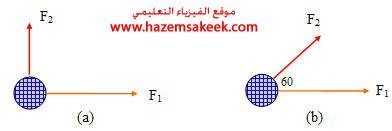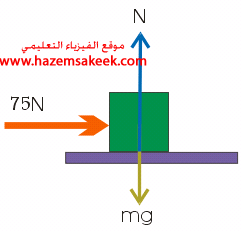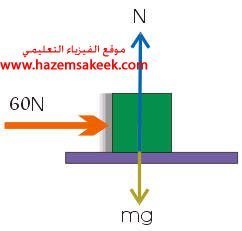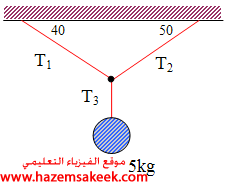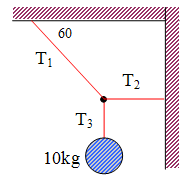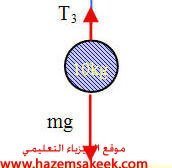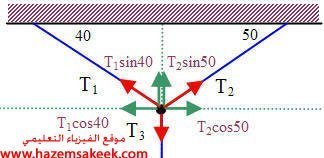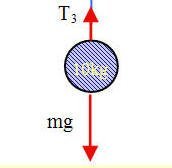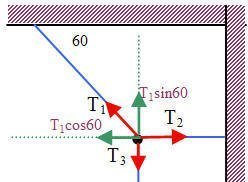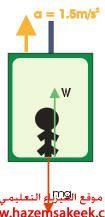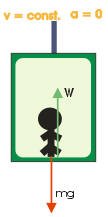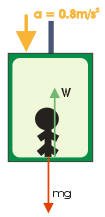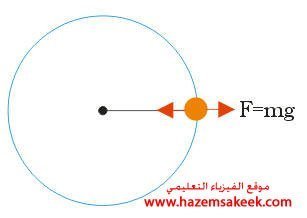محاضرة 16 فيزياء عامة (1) ميكانيكا نيوتن .. تمارين محلولة على قوانين نيوتن للحركة
Mechanics: Dynamics
The Law of Motion
| 1. A force, F, applied to an object of mass m1 produces an acceleration of 3m/s2. The same force applied to a second object of mass m2 produces an acceleration of 1m/s2. (a) What is the value of the ratio m1/m2? (b) If m1 and m2 are combined, find their acceleration under the action of the force F. |
| حيث أن القوة نفسها هي التي أثرت على الكتلتين الاولى والثانية إذا يمكن ايجاد معادلتين لكل كتلة كالتالي:
F = m1 a1 بقسمة المعادلتين نحصل على المطلوب الاول وهو m1 / m2 = a2 / a1 = 1/3 لإيجاد المطوب الثاني يجب ان نعلم أن الجسمين عند تجميعهما فإننا نتعامل مع مجموع الكتلتين تحت تأثير نفس مقدار القوة السابقة وهنا نحصل على m = m1 + m2 F = (m1 + m2) a a = F/(m1 + m2) but F = 3m1 therefore a = 3m1/(m1 + m2) m2 =3m1 a = 3/4 = 0.75m/s2 |
| 2. A 6-kg object undergoes an acceleration of 2 m/s2. (a) What is the magnitude of the resultant force acting on it? (b) If this same force is applied to a 4-kg object, what acceleration will it produce? |
| m1 = 6kg a = 2 m/s2 F = m1 a = 12 N |
m2 = 4kg
a = 3m/s2
| 3. A force of 10N acts on a body of mass 2 kg. What is (a) the acceleration of the body, (b) its weight in N. and (c) its acceleration if the force is doubled? |
| F = 10 N m = 2kg |
(a) a = 5m/s2
(b) W = mg = 20N
(c) a = 10m/s2
| 4. A 3-kg particle starts from rest and moves a distance of 4m in 2s under the action of a single, constant force. Find the magnitude of the force. |
| m = 3kg vo = 0 x-xo = 4m t = 2s F = ?? |
To find the force we use the equation F = ma, and to find the acceleration we use
x – xo = vo t + 1/2 a t2
4 = 0 + 1/2 * a * 4
a = 2 m/s2
F = 3*2 = 6N
| 5. A 5.0-g bullet leaves the muzzle of a rifle with a speed of 320 m/s. What average force is exerted on the bullet while it is travelling down the 0.82m-long barrel of the rifle? |
| m = 5g = 5 x 10-3 kg v = 320m/s x – xo = 0.82 F = ??We need to find the acceleration first, therefore we use the following equation |
v2 – vo2 = 2a (x – xo)
(3202 – 0) = 2 * a * 0.82
a = 62439 m/s2
The average force exerted on the bullet is
F = ma = 5 x 10-3 * 62439 = 312 N
| 6. forces F1 and F2 act on a 5-kg mass. If F1 = 20 N and F2 = 15 N, find the
acceleration in (a) and (b) of the Figure 3.20.
Figure 3.20 |
| a) ΣF = F1 + F2 = (20i + 15j) N
ΣF = ma \20i + 15j = 5 a
a = (4i + 3j) m/s2 or a = 5m/s2
b) F2x = 15 cos 60 = 7.5 N F2y = 15 sin 60 = 13 N F2 = (7.5i + 13j) N åF = F1 + F2 = (27.5i + 13j) = ma = 5 a a = (5.5i + 2.6j) m/s2 or a = 6.08m/s2 |
| 7) An electron of mass 9.1×10-31kg has an initial speed of 3.0×105m/s. It travels in a straight line, and its speed increases to 7.0×105 m/s in a distance of 5.0 cm. Assuming its acceleration is constant, (a) determine the force on the electron and (b) compare this force with the weight of the electron, which we neglected |
| F = ma and v2 = v02 + 2ax or
(b) The weight of the electron is
W = m g = (9.1 ´ 10-31 kg) (9.8 m/s2) = 8.9 ´ 10-30 N
The accelerating force is approximately 1011 times the weight of the electron.
|
| 8. A 25kg block is initially at rest on a rough, horizontal surface. A horizontal force of 75N is required to set the block in motion. After it is in motion, a horizontal force of 60N is required to keep the block moving with constant speed. Find the coefficient of static and kinetic friction from this information. | ||
|
| 9. The coefficient of static friction between a 5kg block and horizontal surface is 0.4. What is the maximum horizontal force that can be applied to the block before it slips? |
| F = ms N = ms mg
F = 0.4 * 5 * 10 = 20N |
| 10. A racing car accelerates uniformly from 0 to 80 km/h in 8s. The external force that accelerates the car is the friction force between the tires and the road. If the tires do not spin, determine the minimum coefficient of friction between the tires and the road |
| 11. Two blocks connected by a light rope are being dragged by a horizontal force F as shown in the Figure . Suppose that F = 50 N, m1 = 10 kg, m2 = 20 kg, and the coefficient of kinetic friction between each block and the surface is 0.1.
(a) Draw a free-body diagram for each block. (b) Determine the tension, T, and the acceleration of the system. |
(a) free-body diagram for each block |
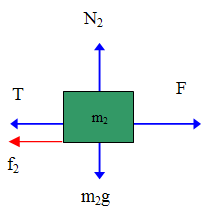
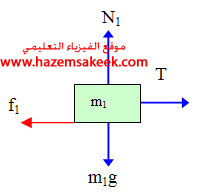
(b)
ΣFx(m1) = T – f1 = m1 a ΣFx(m2) = F – T – f2 = m2 a
ΣFy(m1) = N1 – m1g = 0 ΣFy(m2) = N2 – m2g= 0
The friction force for each block is given by
f1 = m m1g & f2 = m m2g
f1 = 10N & f2 = 20N
Substitute in the above equations we get
T – 10 = 10a
-T + 30 = 20a
Solving these two equation we get
a = 0.66m/s2
T = 16.6N
| 12. The parachute on a race car of weight 8820N opens at the end of a quarter mile run when the car travelling at 55m/s. What is the total retarding force required to stop the car in a distance 1000m in the event of a brake failure? |
| W = 8820 N, g = 9.8 m/s2 , vo = 55 m/s, vf = 0, xf – xo = 1000 m
m = W/g = 900 kg vf 2 = vo2 + 2a(x – xo), 0 = 552 + 2a(1000), giving a = -1.51 m/s2 ΣF = ma = (900 kg) (-1.51 m/s2) = -1.36 ´ 103 N The minus sign means that the force is a retarding force.
|
| 13. Find the tension in each cord for the systems described in the Figure .
|
| نقوم بتحديد نقاط توزيع القوى كما في الشكل التالي
من الشكل الأول نستنتج المعادلة التالية T3 – mg = 0 (1) من الشكل الثاني نقوم بتحليل قوى الشد الاسهم باللون الأخضر ونحصل على المعادلات التالية T2 cos50 – T1 cos40 = 0 (2) T1 sin40 + T2 sin50 – T3 = 0 (3) بحل المعادلات الثلاثة نحصل على قيمة الشد في الخيوط الثلاثة نستخدم نفس التسلسل السابق لايجاد ثلاثة معادلات لإيجاد قيمة الشد في كل خيط
|
| 14. A 72-kg man stands on a spring scale in an elevator starting from rest, the elevator ascends, attaining it maximum velocity of 1.2 m/s in 0.8 s. It travels wit this constant velocity for the next 5.0 s. The elevator then undergoes a uniform negative acceleration for 1.5s and comes to rest. What does the spring scale register (a) before the elevator starts to move (b) during the first 0.8s? (c) while the elevator is travelling at constant velocity? (d) during the negative acceleration period? | ||||||||||||
|
| 15. A toy car completes one lap around a circular track (a distance of 200m) in 25s. (a) What is the average speed? (b) If the mass of the car is 1.5kg, what is the magnitude of the centripetal force that keep it in a circle? |
| (a) the average speed
v = 200/25 = 8 m/s (b) the magnitude of the centripetal force is mv2/r 200 = 2 p r r = 31.8 m F = 3N |
| 16. What centripetal force is required to keep 1.5kg mass moving in a circle of radius 0.4m at speed of 4m/s? |
| استخدم المعادلة التالية:
F = m v2/r |
| 17. A 3kg mass attached to a light string rotates in circular motion on a horizontal, frictionless table. The radius of the circle is 0.8m, and the string can support a mass of 25kg before breaking. What range of speeds can the mass have before the string breaks? | ||
|


